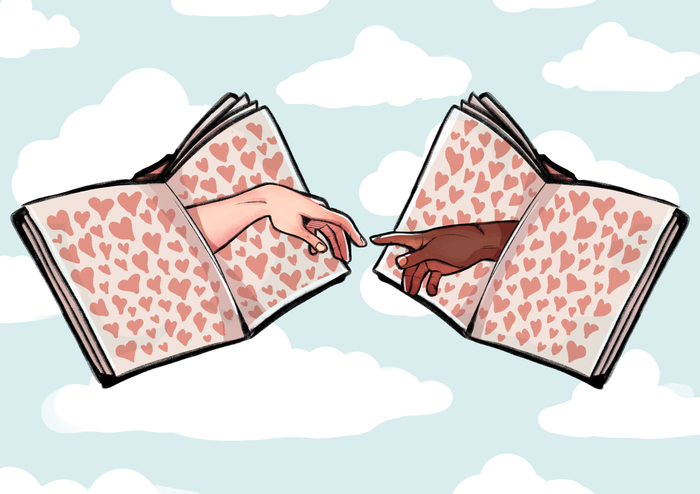Galentine’s Day Reading: My Brilliant Friend
Because the love between friends deserves celebration as much as any other kinds, Isabella Todini reviews ‘My Brilliant Friend’ by Elena Ferrante, the first in a quartet of novels that trace the lifetime of a friendship between two women.

My Brilliant Friend, the first instalment in a series of four novels that traces a lifetime of powerful friendship, was written under the pseudonym Elena Ferrante. It invites readers into the post-World War II periphery of Naples, where we meet the young girls Elena and Lila as they begin to uncover the beauty and violence that coexists in their neighbourhood. Elena narrates the novel – it is through her eyes that we come to know the neighbourhood and its inhabitants, with a particular focus on Lila, who becomes an increasingly magnetic presence in Elena’s life. Ferrante uses intense visual imagery and visceral descriptions of Elena’s emotions to articulate not only the friendship between the two girls but also the joys of learning and writing, as well as the implications of living in a neighbourhood heavy with political and economic struggle. Ferrante’s ability to broach such vast and wide topics while maintaining a focus on Elena’s adolescent life is at the core of what makes this novel so special.
“Ferrante uses intense visual imagery and visceral descriptions of Elena’s emotions to articulate not only the friendship between the two girls but also the joys of learning and writing”
The novel begins with the girls venturing into the building of Don Achille, the infamous neighbourhood loan shark known to Elena as “the ogre of fairy tales”, to reclaim the dolls they believe he has stolen. It is out of a desire to follow Lila that Elena makes the climb up and up the stairs, sweaty and scared, until they reach his front door. The confrontation with the man of their childhood stories and fears is only the first of many dangerous and exhilarating escapades the two girls share together, almost always initiated by Lila’s daring spirit to push boundaries and test limits.
The story then follows the girls as they begin school, discovering their shared passion for literature and writing. Elena and Lila are both talented students, although while Elena is studious and committed, Lila’s intellect comes naturally and sporadically, and she often finds herself at odds with her teachers at school. Ultimately, it is pressure to work for her parents that causes Lila to drop out of school. Ferrante uses the duality of the protagonists to contrast intellectual and personal journeys: Elena pursues a high school education (and a university degree in later novels), while Lila remains stuck in the neighbourhood of their childhood, constrained to her domestic and ultimately unfulfilling life, unable to escape the cultural and social restrictions placed upon her as a working-class Neapolitan woman.
Nevertheless, Elena sees Lila as her role model, particularly as they grow into young adults and are confronted with the desires and conflicts of their male peers. Caught up in romances and ideological debates, Lila flourishes while Elena seems to lag behind. It becomes evident that Ferrante is positioning Lila as Elena’s idealised reflection – the bold, beautiful, and clever young woman Elena wishes to be – and she uses this contrast to reflect on the varied experiences of coming of age as a woman in 1950s Italy, illustrating the global and individual obstacles faced by young women in an environment with a strong focus on male dominance and a dangerously passionate ethos of justice at all costs.
Perhaps the most distinct quality of the novel, however, is the way that Ferrante uses language to construct an intimate and often painful portrayal of the friendship between the two girls as they grow together and apart. The minutiae of adolescent life are expanded to a universal scale as the two girls encounter love, inspiration, hardship, and even trauma by each other’s sides, learning from the other’s mistakes and coming to terms with their places in society together. My favourite passage from the novel is also the one that seems to capture this notion the best. Elena’s father takes her into Naples to visit the sea, and in describing her experience Ferrante wastes not a word: “The waves rolled in like blue metal tubes carrying an egg white of foam on their peaks, then broke in a thousand glittering splinters and came up to the street with an oh of wonder and fear from those watching… At that tremendous moment, full of light and sound, I pretended I was alone in the newness of the city, new myself with all life ahead, exposed to the mutable fury of things but surely triumphant: I, I and Lila, we two with that capacity that together – only together – we had to seize the mass of colours, sounds, things, and people, and express it and give it power”. This passage is a testament to Ferrante’s talent; Elena’s thoughtful engagement with her surroundings and her fundamental bond with Lila are both captured in delicate and poignant imagery, in language that is just as rich as the rest of the novel is.
 News / Uni Scout and Guide Club affirms trans inclusion 12 December 2025
News / Uni Scout and Guide Club affirms trans inclusion 12 December 2025 News / Pembroke to convert listed office building into accom9 December 2025
News / Pembroke to convert listed office building into accom9 December 2025 Features / Searching for community in queer Cambridge10 December 2025
Features / Searching for community in queer Cambridge10 December 2025 News / Uni redundancy consultation ‘falls short of legal duties’, unions say6 December 2025
News / Uni redundancy consultation ‘falls short of legal duties’, unions say6 December 2025 News / Gov declares £31m bus investment for Cambridge8 December 2025
News / Gov declares £31m bus investment for Cambridge8 December 2025









